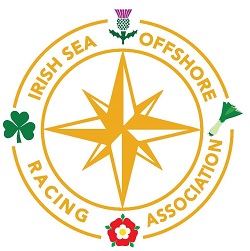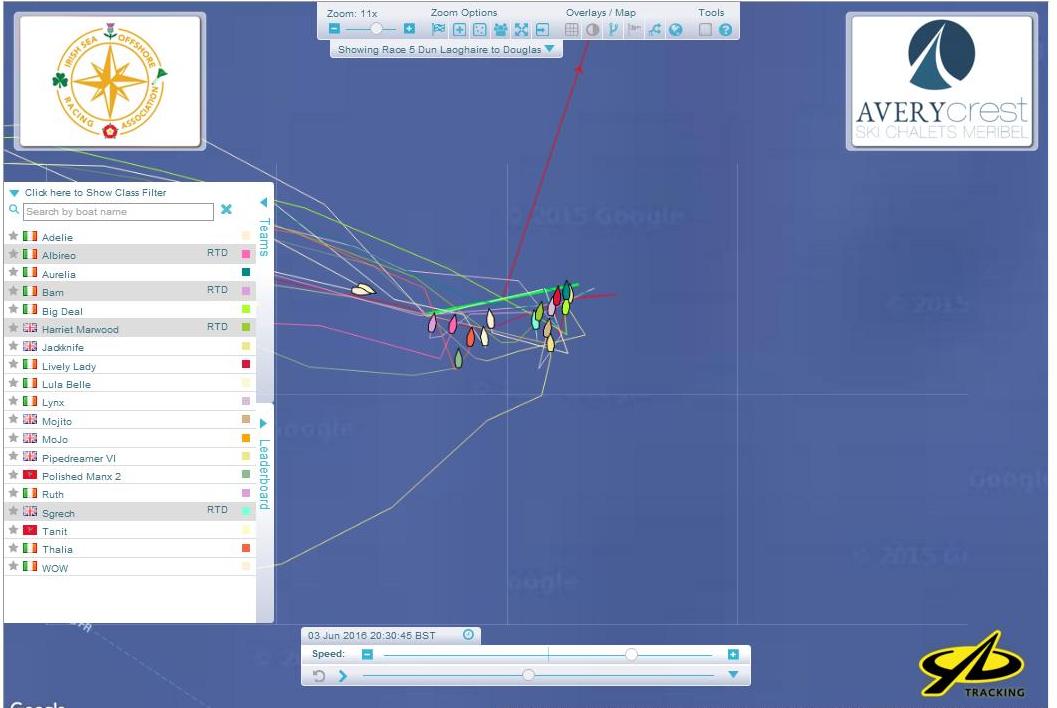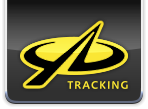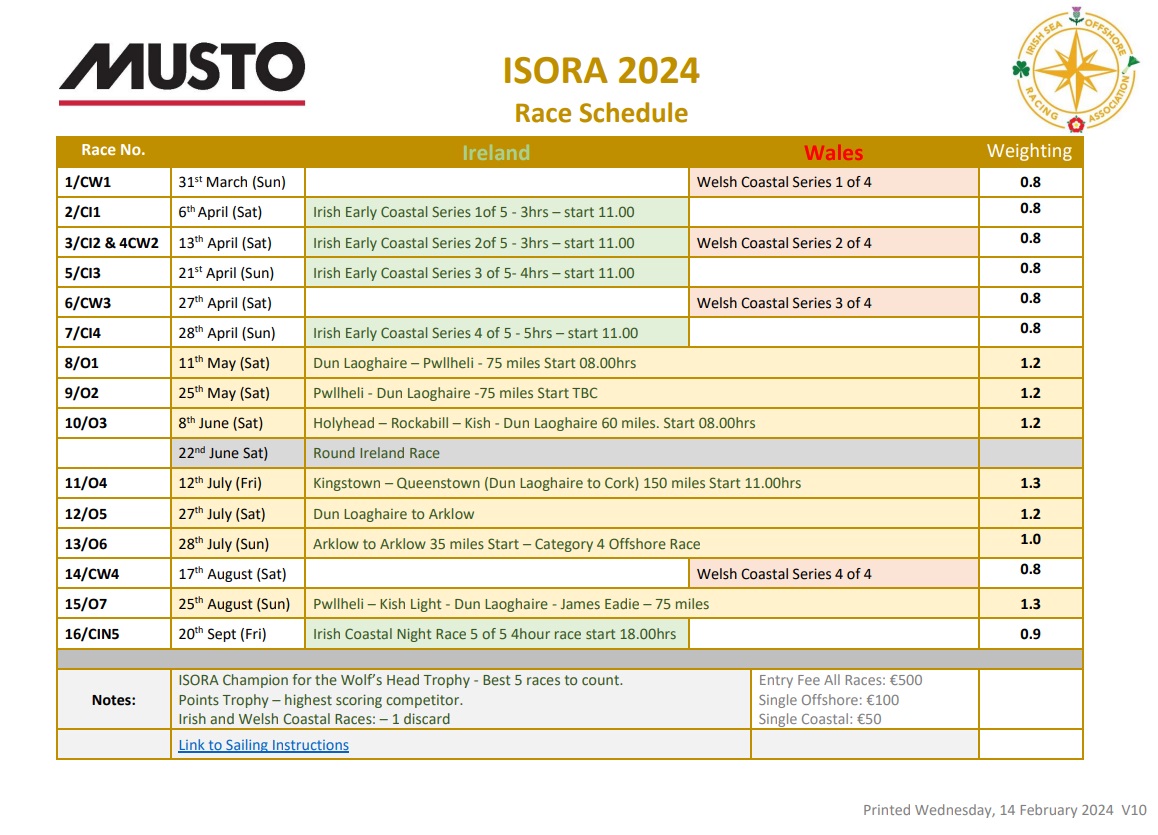The Results for the Avery Crest ISORA Race 5 is published here.
These results include the latest overall table (after 3 races) and the results for Silver Class, Class 1 and Class 2- and the Club Team Trophy points.
 “Innovation by necessity – Virtual Race Management (VRM)”
“Innovation by necessity – Virtual Race Management (VRM)”
Report on Race 5 – Dun Laoghaire to Douglas IOM –
Friday 3rd June – Start 20.30
At the start of the week when long range weather forecasts start approaching reality, the weather forecast for the race from Dun Laoghaire to IOM was indicating NE winds 20-25knots – a big bad long beat!!!
Well after the tame weather conditions earlier in the season for the ISORA races, a good blast could not be unexpected.
As the week progressed, the forecast indicated that the winds were decreasing. That was good. Then decreasing again, that was OK. Then decreasing again to nothing – that was a problem!!! By Friday morning of the race the forecasts were indicating no wind in much of the Irish Sea. Added to this woe was the fact that the tides on the day were strong springs. These are not good conditions for setting a long offshore course.
The usual start was to be provided by Commodores Larry Power and Barry MacNeaney at Pier mark. However the Committee thought that the start there would result in the fleet drifting away from the start line in the strong north going tide and ending over at Dublin Port. This would have made an unusual spectacle for the thousands of people walking the pier on that sunny evening!!!
 The best chance for wind was outside of Dublin bay. To access this, it was decided to use the finish line that was used for the last race, between North Kish cardinal and Kish.
The best chance for wind was outside of Dublin bay. To access this, it was decided to use the finish line that was used for the last race, between North Kish cardinal and Kish.
This obviously posed logistical problems for the starters as it would not be safe to bring a RIB out the 7 miles to the start that late in the evening. These problems were overcome by ISORA by an innovative way of using the Avery Crest YB trackers that each of the 19 boats taking part were provided with. The start time was set at 20.30, the later time allowing boats who were waiting for crew off the ferry to make the extra distance to the start area. The use of the YB trackers with increased “pinging” set at the start time to accurately position every boat at the start time, monitored the start line. Amendments were issued to inform competitors that there would be no committee boat, no flags and there may be no sounds signals. The time was to be taken directly from their GPS, adjusted for BST. This would ensure that the competitors and trackers were working off the same clock.
Amendments were also issued to allow boats use their engine up to when they crossed the start line, even after the official start time. This was necessary for two mains reasons. The first was if any boat underestimated the long trek out to the start area in the strong tides and the second was ensuring that boats were not pulled across the start line by the very strong tide with no wind forecast and unable to get back. To ensure that this rule was not abused the amendment also stated that a boat using his engine after the Warning Signal must complete a 360 degree turn immediately after turning off his engine and before crossing onto the course side of the start line.
The amendments also set out the penalty that would apply to boats over the line at the start – one minute would be added to the boat’s finish time for every second it was over the over the start line after the start time had been reached as recorded by the YB tracker. This is very onerous and kept all boats clear of the start line.
The innovative “Silent Start” worked well despite the total absence of officials on the line. To assist the competitor the Race Organiser, who was taking part in the race, called the count down – 5,4, 1 and Go. No boats were recorded by the trackers as being over the line at the start.
 The finish at Douglas was also unmanned but monitored by the tracker. The finish line was a transit from the signal light at the end of the pier through the No2 buoy and extending the full width of Douglas Bay. Even using human monitoring, it would be extremely difficult to accurately take finish times, particularly at night or poor visibility.
The finish at Douglas was also unmanned but monitored by the tracker. The finish line was a transit from the signal light at the end of the pier through the No2 buoy and extending the full width of Douglas Bay. Even using human monitoring, it would be extremely difficult to accurately take finish times, particularly at night or poor visibility.
This is no problem to the Avery Crest YB Trackers!!! The line was set out by YB and the “pinging” increased as each boat entered a selected zone before the finish line. The YB system records the time that every boat crosses that imaginary finish line. Trial on this last season showed the difference to sight times to be no more than +/- 5 seconds. There was no need for boats to call the “Finisher” and all finishes were recorded with the same accuracy.
This system worked well with good comparisons between the YB intercept time and those declared by each of the finish boats as part if their mandatory declaration text after every race.
 This innovative use of the Avery Crest YB trackers can also allow the formation of a finish anywhere and can allow the shortening of an offshore race in the situation where weather conditions require, on life or mental safety reasons???? Example – Severe weather warning not forecast or the total lack of weather not forecast. The line can be set anywhere and identified by two waypoint coordinates. “Innovation by necessity”.
This innovative use of the Avery Crest YB trackers can also allow the formation of a finish anywhere and can allow the shortening of an offshore race in the situation where weather conditions require, on life or mental safety reasons???? Example – Severe weather warning not forecast or the total lack of weather not forecast. The line can be set anywhere and identified by two waypoint coordinates. “Innovation by necessity”.
Anyway that description of ISORA’s innovative race management, was by way of introducing the report on Race 5 on Friday evening from Dun Laoghaire to Douglas IOM. There did not appear to be any wind at the start line but miraculously enough wind appeared just before the start to move the fleet off the start line and on towards Douglas.
The wind from the west was very light and fickle but with the strong tide pushing the fleet north, the effect of what wind was that it gave the boats great speed over the ground. These condition held for most of the evening but things started to happen – and I don’t know what?? The fickle winds veered to the north in line with the forecast and kept the boats moving. Then the fickle winds veered again to the north east – so far so good. As the fleet was 20-30 miles off the finish – all of a sudden – Nothing!!! The wind dropped completely but the tide was still pushing boats north easterly towards the IOM.
The leading and faster boats, “Aurelia”, “WOW”, “Lively Lady” “Lynx” and “Jackknife” all slipped across the finish line in Douglas Bay with the last of the north going tide. Those poor unfortunates who had not finished by then were unmercifully treated by the new south going tide.
In the fickle winds no progress could be made in the 2-3 knot tide that raced along the south east coast of the island. If boats could not get into bays for refuge, they were whisked away by the tide, back into the Irish Sea. Those who could crawl into the many bays along the IOM coast fared no better. While they were not dragged back into the Irish Sea, they could not get out of the bays and remained on hold until the next north going tide. These frustrating conditions forced many boats to retire while other held their positions and proceeded to the finish line, 6 hours later.
Andrew Hall’s “Jackknife” took line honours arriving at 09:52 on Saturday morning but failed to take Overall or Class 1. Chris Power Smith’s “Aurelia” snatched those accolades from “Jackknife”. Peter Hall’s “Adelie” took Class 2 and Derek & Conor Dillon’s “Big Deal” took the 2-handed and the Silver Class.
After 5 races the existing ISORA Champion Liam Shanahan “Ruth” still holds poll position with “Adelie”, “Aurelia” and Peter Dunlop’s “Mijito” very close behind. The National YC is leading the Team Prize chased by Pwllheli SC. All exciting stuff!!
The arriving boats were treated to a complimentary breakfast prepared by the IOM Sea Cadets. Unfortunately for those boats that did not get in at the first tide, it was going to be brunch or even dinner.
The next race is on the 2nd July, the Adrian Lee & Partner’s “Lighthouse Race”. This is a day race that will be run in conjunction with the Royal St. George YC regatta. This race is also part of the Royal Alfred YC Viking Marine Coastal Series. It is hoped that all ISORA boats will also enter the RStGYC regatta and take part in their great social activities after the race. It is also hoped that new boats entering the RStGYC regatta will opt to take part in this ISORA / RAYC coastal race as well.
The course for the race will be selected to ensure that all boats taking part will finish in time to take full part in the regatta’s social program. The Adrian Lee & Partners “Lighthouse Race” trophy will be presented at the RStGYC’s regatta prize giving that evening.
The Results for the Avery Crest ISORA Race 5 is published here.







